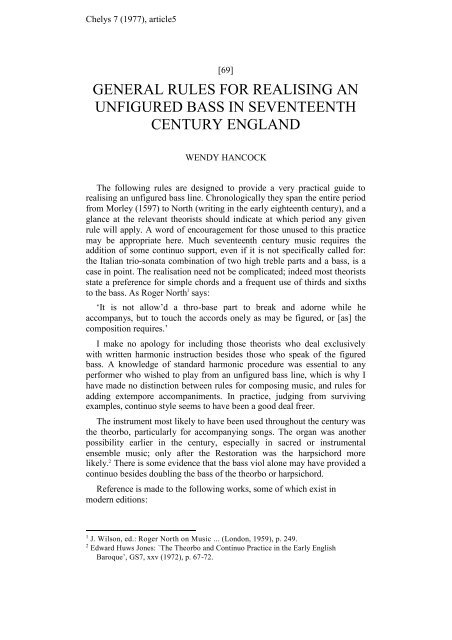download.pdf - 6.3Mb - Viola da Gamba Society
download.pdf - 6.3Mb - Viola da Gamba Society
download.pdf - 6.3Mb - Viola da Gamba Society
Create successful ePaper yourself
Turn your PDF publications into a flip-book with our unique Google optimized e-Paper software.
Chelys 7 (1977), article5<br />
[69]<br />
GENERAL RULES FOR REALISING AN<br />
UNFIGURED BASS IN SEVENTEENTH<br />
CENTURY ENGLAND<br />
WENDY HANCOCK<br />
The following rules are designed to provide a very practical guide to<br />
realising an unfigured bass line. Chronologically they span the entire period<br />
from Morley (1597) to North (writing in the early eighteenth century), and a<br />
glance at the relevant theorists should indicate at which period any given<br />
rule will apply. A word of encouragement for those unused to this practice<br />
may be appropriate here. Much seventeenth century music requires the<br />
addition of some continuo support, even if it is not specifically called for:<br />
the Italian trio-sonata combination of two high treble parts and a bass, is a<br />
case in point. The realisation need not be complicated; indeed most theorists<br />
state a preference for simple chords and a frequent use of thirds and sixths<br />
to the bass. As Roger North 1 says:<br />
‘It is not allow’d a thro-base part to break and adorne while he<br />
accompanys, but to touch the accords onely as may be figured, or [as] the<br />
composition requires.’<br />
I make no apology for including those theorists who deal exclusively<br />
with written harmonic instruction besides those who speak of the figured<br />
bass. A knowledge of stan<strong>da</strong>rd harmonic procedure was essential to any<br />
performer who wished to play from an unfigured bass line, which is why I<br />
have made no distinction between rules for composing music, and rules for<br />
adding extempore accompaniments. In practice, judging from surviving<br />
examples, continuo style seems to have been a good deal freer.<br />
The instrument most likely to have been used throughout the century was<br />
the theorbo, particularly for accompanying songs. The organ was another<br />
possibility earlier in the century, especially in sacred or instrumental<br />
ensemble music; only after the Restoration was the harpsichord more<br />
likely. 2 There is some evidence that the bass viol alone may have provided a<br />
continuo besides doubling the bass of the theorbo or harpsichord.<br />
Reference is made to the following works, some of which exist in<br />
modern editions:<br />
1 J. Wilson, ed.: Roger North on Music ... (London, 1959), p. 249.<br />
2 Edward Huws Jones: `The Theorbo and Continuo Practice in the Early English<br />
Baroque’, GS7, xxv (1972), p. 67-72.
















